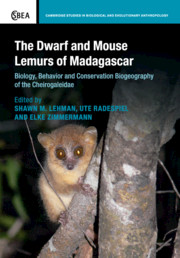 The Dwarf and Mouse Lemurs of Madagascar
The Dwarf and Mouse Lemurs of Madagascar Book contents
- Frontmatter
- Contents
- List of contributors
- Foreword
- Part I Cheirogaleidae: evolution, taxonomy, and genetics
- Part II Methods for studying captive and wild cheirogaleids
- Part III Cheirogaleidae: behavior and ecology
- Part IV Cheirogaleidae: sensory ecology, communication, and cognition
- 18 Seed dispersal by mouse lemurs: do Microcebus represent a unique frugivorous guild?
- 19 Predation in the dark: antipredator strategies of Cheirogaleidae and other nocturnal primates
- 20 The gray mouse lemur (Microcebus murinus): a novel cognitive primate brain aging model
- 21 Acoustic divergence in communication of cheirogaleids with special emphasis to mouse lemurs
- 22 Modeling the origins of primate sociality: social fl exibility and kinship in mouse lemurs (Microcebus spp.)
- Part V Cheirogaleidae: conservation biogeography
- Index
- Plate section
- References
20 - The gray mouse lemur (Microcebus murinus): a novel cognitive primate brain aging model
from Part IV - Cheirogaleidae: sensory ecology, communication, and cognition
Published online by Cambridge University Press: 05 March 2016
- Frontmatter
- Contents
- List of contributors
- Foreword
- Part I Cheirogaleidae: evolution, taxonomy, and genetics
- Part II Methods for studying captive and wild cheirogaleids
- Part III Cheirogaleidae: behavior and ecology
- Part IV Cheirogaleidae: sensory ecology, communication, and cognition
- 18 Seed dispersal by mouse lemurs: do Microcebus represent a unique frugivorous guild?
- 19 Predation in the dark: antipredator strategies of Cheirogaleidae and other nocturnal primates
- 20 The gray mouse lemur (Microcebus murinus): a novel cognitive primate brain aging model
- 21 Acoustic divergence in communication of cheirogaleids with special emphasis to mouse lemurs
- 22 Modeling the origins of primate sociality: social fl exibility and kinship in mouse lemurs (Microcebus spp.)
- Part V Cheirogaleidae: conservation biogeography
- Index
- Plate section
- References
Summary
Introduction
The use of the small cheirogaleid, the gray mouse lemur (Microcebus murinus, which will be referred to as “mouse lemur” throughout this chapter), for laboratory studies of the brain and cognitive aging began in the early 1990s (Bons et al., 1991, 1994; Picq, 1992, 1993; Mestre and Bons, 1993). In the decades that followed, several research groups have become interested in M. murinus and carried out routine assessment of cognitive capacities on various behavioral tasks (see present review). Therefore, the mouse lemur represents an exception among the prosimians, which were largely ignored for a long time by researchers studying cognition. Indeed, when consulting a textbook, such as Primate Cognition (Tomasello and Call, 1997), the following type of remark is commonly encountered: “as usual, we know little about cognitive skills of prosimians …”. In fact, there was a longstanding lack of interest regarding the investigation of cognitive functions in prosimians, which resulted from two major ideas. First, prosimians were generally thought to be untrainable, as they were considered to be nervous, easily distracted, and non-cooperative (Wilkerson and Rumbaugh, 1979). Early attempts to work with these animals were very disappointing. For example, it was reported that “when removed from the home cage, lemurs grew hysterical, lorisoids sulked, and both refused to work” (Jolly, 1964b). Second, prosimians were believed to be less intelligent when compared to other primates. It was claimed that “Old and New World monkeys' intelligence outdistanced that of other mammals, including the prosimian primates” (Jolly, 1966). Two major explanations were proposed to explain the modest cognitive capacity of prosimians. First of all, it was suggested that they have found an ecological niche in which intelligence is not required (i.e., a niche with reduced opportunities for competition between species) (Andrew, 1962; Jolly, 1966). Second, they have been described as primitive, representing “surviving approximations of those ancestral primate forms from whose core components the higher primates evolved” (Wilkerson and Rumbaugh, 1979). Indeed, according to the view of Le Gros Clark (1959), the primate order is composed of a series of forms that are successive approximations of the evolutionary antecedents of man (characterized by high cognitive abilities), with prosimians at the bottom of the scale.
Information
- Type
- Chapter
- Information
- The Dwarf and Mouse Lemurs of MadagascarBiology, Behavior and Conservation Biogeography of the Cheirogaleidae, pp. 381 - 404Publisher: Cambridge University PressPrint publication year: 2016
References
Accessibility standard: Unknown
Why this information is here
This section outlines the accessibility features of this content - including support for screen readers, full keyboard navigation and high-contrast display options. This may not be relevant for you.Accessibility Information
- 2
- Cited by